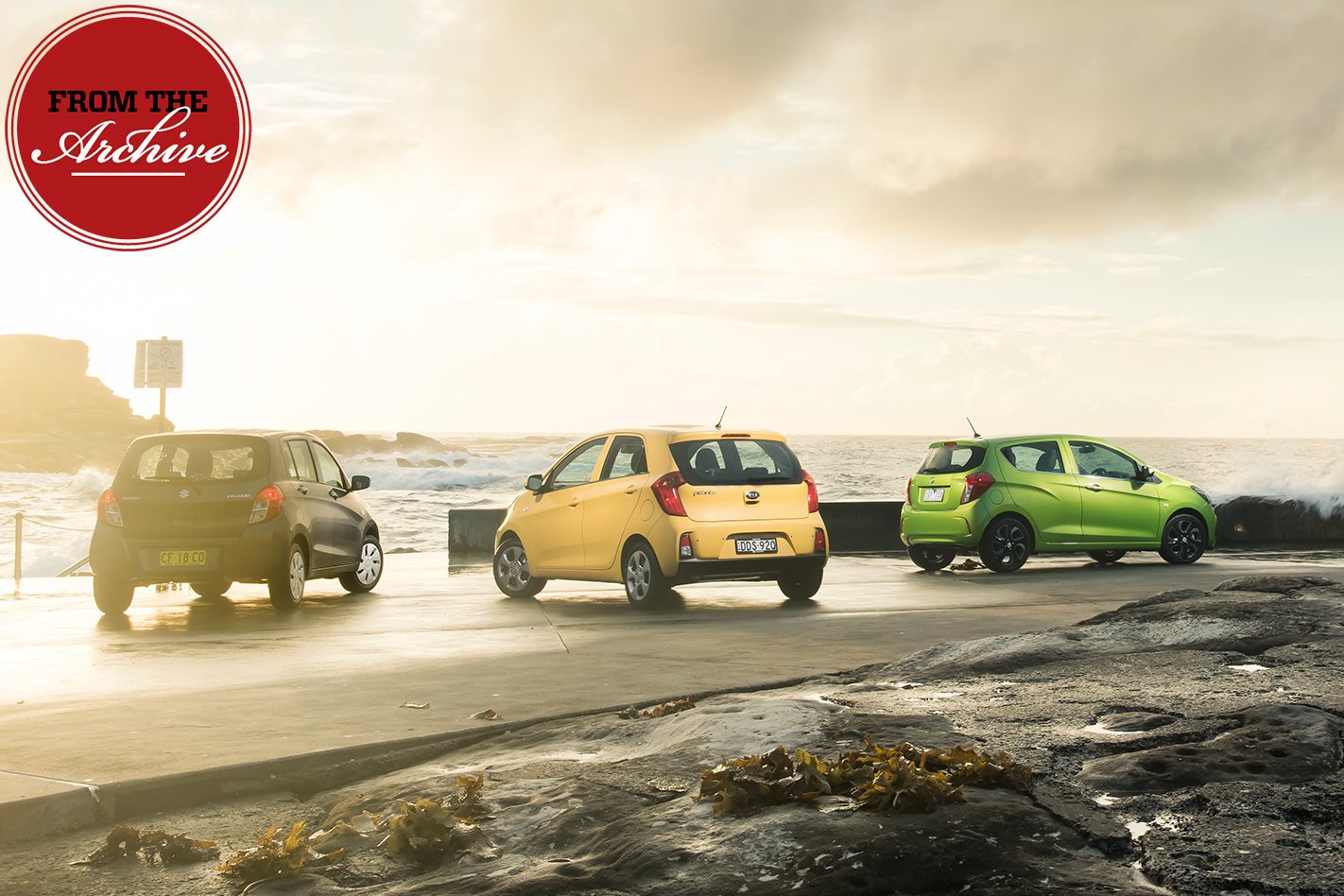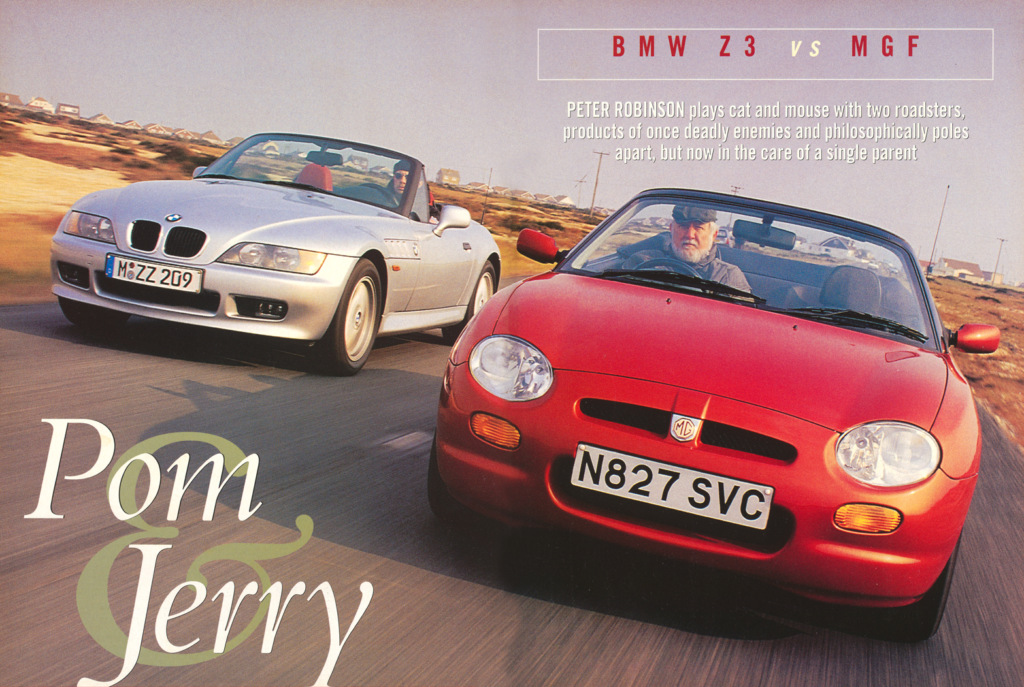First published in the July 2016 issue of Wheels magazine, Australia’s best car mag since 1953.
New baby Holden Sparks a $15K battle with crisp class fave Suzuki Celerio and spicy newcomer Kia Picanto.
WHY do kids want to grow up so fast? In no time they’re adults, and there’s no way back to the days of carefree youth.
A similar mindset afflicts carmakers. Take the latest Barina (please!). Once the feisty “beep-beep” baby of Holden’s 1980s line-up, today it’s nearly two sizes larger and half a tonne heavier, but also about half as much fun.
In 2010, Holden introduced a smaller Barina ‘Spark’ to fill the gap at the bottom of its line-up, but this rough little appliance simply made the real Barina look better value. This time, however, we’re promised that the second-generation Holden Spark out of Korea (but via Holden’s Lang Lang Proving Ground finishing school) has matured rather than merely changed.
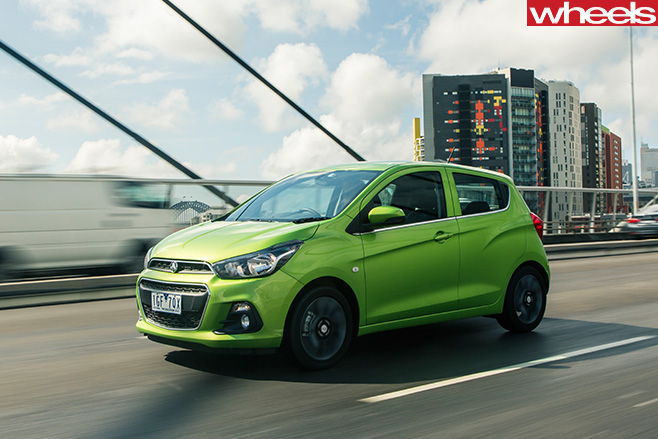
A much stronger body for improved dynamics and reduced NVH (central to the previous Spark’s sorrows) is just the beginning; a fresh 1399cc naturally aspirated four-cylinder engine, Holden’s first continuously variable transmission (replacing an old four-speed auto) and heavily Australianised suspension, steering, and drivetrain calibrations also accompany the Lion cub’s road to newfound maturity.
The genesis of this comparison was during COTY testing at Lang Lang last year, when Holden senior vehicle dynamics engineer (and Nurburgring ute lap record holder) Rob Trubiani reckoned the then-upcoming Spark would be a game-changer. He had just witnessed each of the eight judges returning – some with giant grins – after a stint in one of our favourite micro contenders, the Suzuki Celerio.
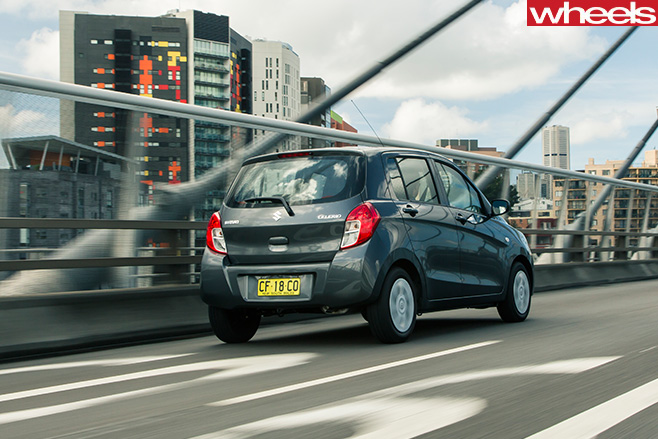
The battle of the babies was on!
Suzuki’s dowdy yet delightfully obedient Celerio was released in early 2015 amid international controversy over a brake-pedal bracket that was worryingly prone to breaking. It was quickly rectified and the Thai-built Japanese hatch dodged a scandal, while its plain styling became easy to overlook because it was roomy, refined, fun and only $13K driveaway.
Our third contender, the Kia Picanto, is new to Australia but already five years old elsewhere and due for replacement soon. Belatedly arriving here in only one specification, the Picanto Si is a 1.2-litre automatic priced at $14,990 driveaway.
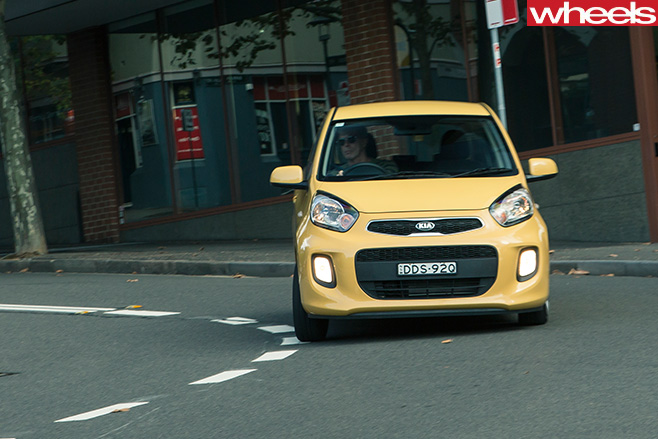
No wonder Kia is confident it can sell 300 a month, or about 40 percent of the total segment, while luring potential used-car buyers. Ambitious stuff.
The $14,490-driveaway Celerio auto’s $500 advantage over Picanto is diminished by having only a four-star ANCAP crash test rating (mainly due to an average pedestrian-impact result), as well as this test’s sole four-seat configuration.
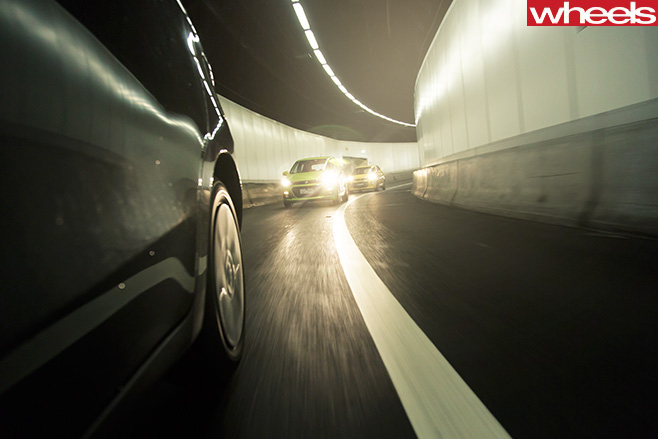
Such features accentuate how sophisticated the Spark’s cabin is for this segment, starting the moment a hefty door thuds closed. With a large central touchscreen, big-car dash layout, sturdy materials and pleasing finish, it seems Germanic in essence, as if Opel rather than Chevrolet dictated the interior.
Gone is the old car’s messy ‘motorcycle-inspired’ analogue/digital instrumentation cluster-fudge, replaced by conventional yet classy dials. Plenty of thought clearly went into the switchgear layout, the three-spoke wheel is of Commodore quality and the driving position benefits from the arrival of seat-height adjustment.
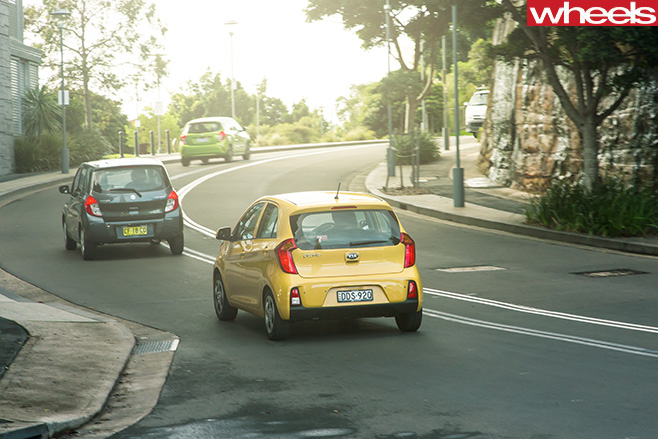
Annoyances include the lack of an auto-down driver’s electric window (Picanto and Celerio both have it), wind-down rear windows and a small glovebox, as well as instruments that reflect sunlight, central vents hell-bent on freezing hands, zero back-seat storage and a parcel shelf that doesn’t flip down automatically when you close the rear hatch – an infuriation when you get back in, glance in the mirror and see cardboard where a window should be.

It is therefore doubly disappointing to discover sub-par audio quality, a misaligned dash speaker cover and some rattly door trim at speed, undermining the Picanto’s quality. We’re also disappointed with the poor front-seat thigh support and lack of door storage, but we can accept that, as a city-car, rear legroom is limited, especially with three adults in the back.
The opposite is true of the Celerio, which was designed to be the roomiest sub-B runabout ever, aided by the longest wheelbase and highest roof here. Which makes the decision to offer only four seats a wasted opportunity.
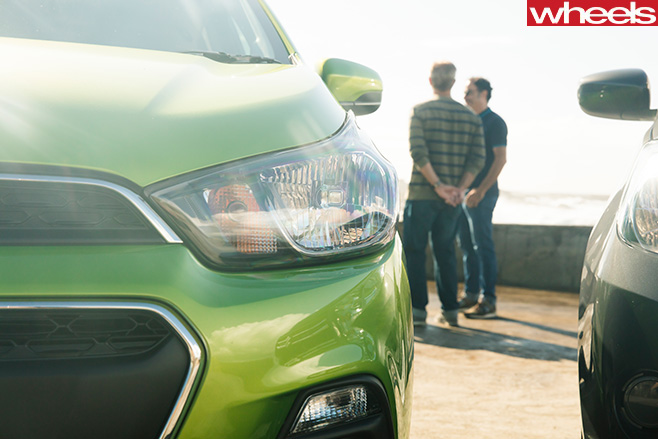
Celerio downsides include front headrests that protrude too far forward, rattles that were apparent in our test car, plenty of noise intrusion at highway speeds, and a dated Bluetooth connectivity set-up that proves confusing.
None of these three hatches feature Autonomous Emergency Braking – even though the Volkswagen Up did so as standard in 2012 – or reach-adjustable steering, a digital speedo or cruise control.
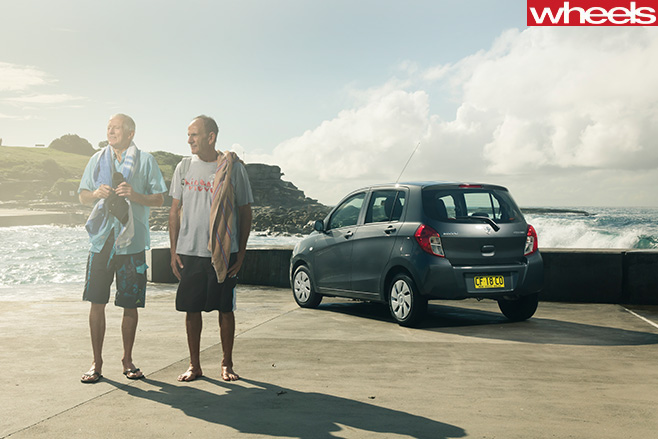
A 10.8sec sprint to 100km/h makes Spark the quickest here, and those extra cubic centimetres deliver dividends on a flat or straight road. Introduce corners or hills, however, and the CVT’s relative laziness is telling, taking its time downshifting to a lower ‘gear’. And there’s no manual over-ride for the driver to assume control.
More significant for a city-car is economy. Despite being 4kg lighter than the 994kg Kia, the Holden’s thirst proved worrying, guzzling 98-octane brew (though it can run on 91RON) at 8.5L/100km – a litre more than Picanto and 2.4L/100km worse than the Celerio. If this is the best a so-called all-new chassis and powertrain can achieve, then it’s not good enough, GM.

Quiet and polished pottering around town, the Kia automatic shuffles between ratios unobtrusively, providing sufficient oomph when needed to thrust quickly through tiny traffic gaps. Even when floored, the Picanto punches harder than its modest spec would suggest.
Away from urban confines, its lack of capacity and gears is more noticeable, and here the Holden charges away. But all the Kia driver has to do is pull the lever down to third or second and the trannie will hold each ratio to the redline, making the most of the available power to keep the Spark in sight. Transformative and involving, it adds a delightful manual dimension lacking in the others. Call it an oldie but a goodie.

A bit more feel and response from the Celerio’s slightly doughy steering would be appreciated, but it is ridiculously easy to drive quickly, has a very tight turning circle, and irons out urban bumps with almost French-car suppleness.
While there isn’t really enough power to alter the chassis’ composure on faster rural roads, the steering firms up nicely and turns in faithfully while the car feels planted. But Celerio’s ride deteriorates on rough roads and its cabin starts to sound like a wasp in an empty drum. Raw, noisy fun.
But not as much fun as the Picanto, which turns it up a notch around town in terms of steering feel and reactivity, with a naturally composed attitude. It moves a bit more on its suspension over bumps but remains comfortable.
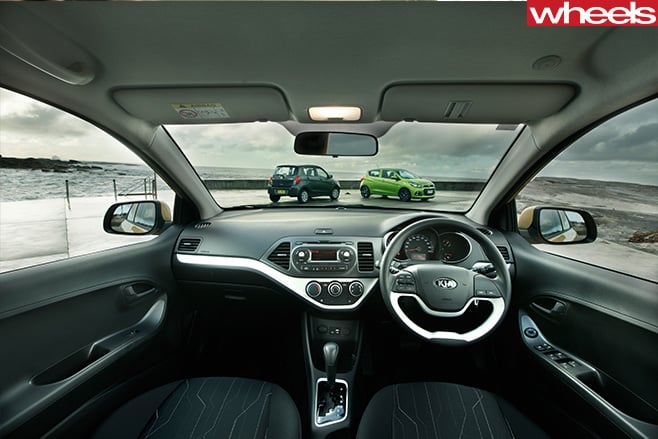
Holden tuned and honed the Spark on Australian roads to the point where it behaves more grown-up than either rival, or any sub-B hatch on the market, and on a number of fronts. Its steering is responsive yet linear and full of feel, resulting in poised and secure roadholding, and just as impressive is its ability to soak up bad surfaces, especially around town. The change is profound over the preceding version, though road noise can be intrusive.
What’s missing from the Spark is verve and – ironically – sparkle. You can scoot along a snaking B-road and totally rejoice at what Trubiani’s team has achieved dynamically, but there’s a lack of adjustability to the chassis that makes it seem a bit dull. A muted charm.
Nevertheless, Spark pushes class boundaries for steering, handling, ride and refinement. But we’re a bit disillusioned by its slightly underwhelming drivetrain performance, its relative thirst and various spec anomalies. While it wins this fight, the winning margin should be greater.
The opposite is true of the Picanto, which punches well above its weight for fun and feistiness, then backs that up with refinement, economy and outstanding value. Well done, Kia. It nips at the Holden’s heels like a lovable terrier.
A respectable third (rather than last) is where the Celerio lands. Save for a boomy cabin and four-seat configuration, it continues to charm with its frugality, huge interior, lively performance, sorted handling and excellent inner-city ride. Its virtues are truly its own.
While newfound maturity has seen a baby Holden win a Wheels comparison test for the first time in forever, it shouldn’t be in too much of a rush to outgrow youthful exuberance – something the Kia and Suzuki possess in spades.

